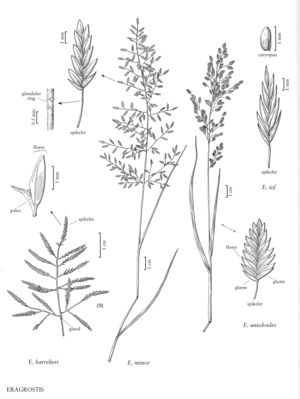Difference between revisions of "Eragrostis minor"
FNA>Volume Importer |
imported>Volume Importer |
||
| (6 intermediate revisions by 2 users not shown) | |||
| Line 4: | Line 4: | ||
|publications= | |publications= | ||
|common_names=Little lovegrass;Eragrostide faux-paturin | |common_names=Little lovegrass;Eragrostide faux-paturin | ||
| + | |special_status={{Treatment/ID/Special_status | ||
| + | |code=I | ||
| + | |label=Introduced | ||
| + | }} | ||
|basionyms= | |basionyms= | ||
|synonyms={{Treatment/ID/Synonym | |synonyms={{Treatment/ID/Synonym | ||
|name=Eragrostis poaeoides | |name=Eragrostis poaeoides | ||
| − | |authority= | + | |authority= |
| + | |rank=species | ||
}} | }} | ||
|hierarchy=Poaceae;Poaceae subfam. Chloridoideae;Poaceae tribe Cynodonteae;Eragrostis;Eragrostis minor | |hierarchy=Poaceae;Poaceae subfam. Chloridoideae;Poaceae tribe Cynodonteae;Eragrostis;Eragrostis minor | ||
| Line 19: | Line 24: | ||
-->{{Treatment/Body | -->{{Treatment/Body | ||
| − | |distribution=Wash.;Del.;D.C;Wis.;W.Va.;Conn.;Mass.;Maine;N.H.;R.I.;Vt.;Fla.;Wyo.;N.J.;Tex.;La.;Nebr.;Tenn.;N.C.;S.C.;Pa.;N.Y.;Nev.;Va.;Colo.;Md.;Calif.;Ala.;Ark.;Ill.;Ga.;Ind.;Iowa;B.C.;N.B.;N.S.;Ont.;P.E.I.;Que.;Sask.;Idaho;Mont.;Oreg.;Kans.;Okla.;Ohio;Utah;Mo.;Minn.;Mich.;Miss.;Ky.;S.Dak. | + | |distribution=Wash.;Del.;D.C.;Wis.;W.Va.;Conn.;Mass.;Maine;N.H.;R.I.;Vt.;Fla.;Wyo.;N.J.;Tex.;La.;Nebr.;Tenn.;N.C.;S.C.;Pa.;N.Y.;Nev.;Va.;Colo.;Md.;Calif.;Ala.;Ark.;Ill.;Ga.;Ind.;Iowa;B.C.;N.B.;N.S.;Ont.;P.E.I.;Que.;Sask.;Idaho;Mont.;Oreg.;Kans.;Okla.;Ohio;Utah;Mo.;Minn.;Mich.;Miss.;Ky.;S.Dak. |
|discussion=<p><i>Eragrostis minor</i> is a European species that now grows in gravelly roadsides and disturbed sites, especially near railroad yards, at 20-1600 m in southern Canada and the contiguous United States.</p> | |discussion=<p><i>Eragrostis minor</i> is a European species that now grows in gravelly roadsides and disturbed sites, especially near railroad yards, at 20-1600 m in southern Canada and the contiguous United States.</p> | ||
|tables= | |tables= | ||
| Line 29: | Line 34: | ||
-->{{#Taxon: | -->{{#Taxon: | ||
name=Eragrostis minor | name=Eragrostis minor | ||
| − | |||
|authority=Host | |authority=Host | ||
|rank=species | |rank=species | ||
| Line 36: | Line 40: | ||
|basionyms= | |basionyms= | ||
|family=Poaceae | |family=Poaceae | ||
| − | |distribution=Wash.;Del.;D.C;Wis.;W.Va.;Conn.;Mass.;Maine;N.H.;R.I.;Vt.;Fla.;Wyo.;N.J.;Tex.;La.;Nebr.;Tenn.;N.C.;S.C.;Pa.;N.Y.;Nev.;Va.;Colo.;Md.;Calif.;Ala.;Ark.;Ill.;Ga.;Ind.;Iowa;B.C.;N.B.;N.S.;Ont.;P.E.I.;Que.;Sask.;Idaho;Mont.;Oreg.;Kans.;Okla.;Ohio;Utah;Mo.;Minn.;Mich.;Miss.;Ky.;S.Dak. | + | |illustrator=Linda A. Vorobik;Cindy Roché |
| + | |illustration copyright=Utah State University | ||
| + | |distribution=Wash.;Del.;D.C.;Wis.;W.Va.;Conn.;Mass.;Maine;N.H.;R.I.;Vt.;Fla.;Wyo.;N.J.;Tex.;La.;Nebr.;Tenn.;N.C.;S.C.;Pa.;N.Y.;Nev.;Va.;Colo.;Md.;Calif.;Ala.;Ark.;Ill.;Ga.;Ind.;Iowa;B.C.;N.B.;N.S.;Ont.;P.E.I.;Que.;Sask.;Idaho;Mont.;Oreg.;Kans.;Okla.;Ohio;Utah;Mo.;Minn.;Mich.;Miss.;Ky.;S.Dak. | ||
|reference=None | |reference=None | ||
|publication title= | |publication title= | ||
|publication year= | |publication year= | ||
| − | |special status= | + | |special status=Introduced |
| − | |source xml=https:// | + | |source xml=https://bitbucket.org/aafc-mbb/fna-data-curation/src/200273ad09963decb8fc72550212de541d86569d/coarse_grained_fna_xml/V25/V25_136.xml |
|subfamily=Poaceae subfam. Chloridoideae | |subfamily=Poaceae subfam. Chloridoideae | ||
|tribe=Poaceae tribe Cynodonteae | |tribe=Poaceae tribe Cynodonteae | ||
Latest revision as of 17:56, 11 May 2021
Plants annual; tufted, without innovations. Culms 10-45 cm, erect to decumbent, sometimes with a ring of glandular tissue below the nodes. Sheaths sometimes glandular on the midveins, hairy at the apices, hairs to 4 mm; ligules 0.2-0.5 mm, ciliate; blades 1.5-10 cm long, 1-3(4) mm wide, flat, glabrous or sparsely white-hairy, margins sometimes with crateriform glands. Panicles 4-20 cm long, 2.2-8(10) cm wide, ovate, open to contracted, rachises sometimes with glandular spots or pits below the nodes, rarely with a glandular ring, glands usually dull, greenish-gray to stramineous; primary branches 0.5-6 cm, diverging 20-100° from the rachises; pulvini glabrous or hairy; pedicels 1-4 mm, stiff, straight, divergent, usually with a distal ring of crateriform glands. Spikelets 4-7(11) mm long, 1.1-2.2 mm wide, narrowly ovate, mostly reddish-purple to greenish, occasionally grayish, with 7-12(20) florets; disarticulation acropetal, paleas persistent. Glumes broadly ovate, membranous; lower glumes 0.9-1.4 mm; upper glumes 1.2-1.6 mm; lemmas 1.4-1.8 mm, broadly ovate, membranous, keels occasionally with 1-2 crateriform glands, apices acute to obtuse; paleas 1.3-1.7 mm, hyaline, keels smooth or scabridulous, scabridities to 0.1 mm, apices obtuse to acute; anthers 2, 0.2-0.3 mm, reddish-brown. Caryopses 0.4-0.7 mm, ellipsoid, not grooved, striate, light brown. 2n = 40.
Distribution
Wash., Del., D.C., Wis., W.Va., Conn., Mass., Maine, N.H., R.I., Vt., Fla., Wyo., N.J., Tex., La., Nebr., Tenn., N.C., S.C., Pa., N.Y., Nev., Va., Colo., Md., Calif., Ala., Ark., Ill., Ga., Ind., Iowa, B.C., N.B., N.S., Ont., P.E.I., Que., Sask., Idaho, Mont., Oreg., Kans., Okla., Ohio, Utah, Mo., Minn., Mich., Miss., Ky., S.Dak.
Discussion
Eragrostis minor is a European species that now grows in gravelly roadsides and disturbed sites, especially near railroad yards, at 20-1600 m in southern Canada and the contiguous United States.
Selected References
None.
